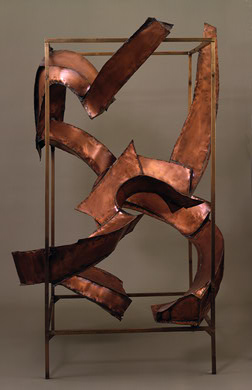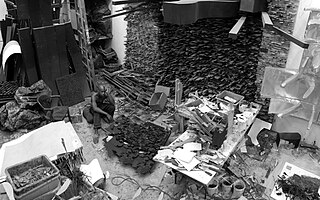Related Research Articles

David Vincent Hayes was an American sculptor.

The DeCordova Sculpture Park and Museum is a sculpture park and contemporary art museum on the southern shore of Flint's Pond in Lincoln, Massachusetts, 20 miles northwest of Boston. It was established in 1950, and is the largest park of its kind in New England, encompassing 30 acres.
Philip Grausman is an American sculptor who continues to push the limits of the time-honored portrait in art.
David Hilliard is an American photographer. A fine arts photographer who works mainly with panoramic photographs, he draws inspiration from his personal life and those around him for his subject matter. Many of the scenes are staged, evoking a performative quality, a middle ground between fact and fiction.

Herbert Ferber was an American Abstract Expressionist, sculptor and painter, and a "driving force of the New York School."
Judith Brown was an American dancer and a sculptor who was drawn to images of the body in motion and its effect on the cloth surrounding it. She welded crushed automobile scrap metal into energetic moving torsos, horses, and flying draperies. "One of the things that made Judy stand out as an artist was her ability to work in many different mediums. Some of this was by choice, and sometimes it was by necessity. Her surroundings often dictated what medium she could work with at any given time. After all, you can't bring you're welding gear with you to Rome."
Tetsuo Ochikubo (1923–1975), also known as Bob Ochikubo, was a Japanese-American painter, sculpture, and printmaker who was born in Waipahu, Hawaii, Honolulu county, Hawaii. During the Second World War, he served with the 100th Battalion of the 442nd Regimental Combat Team. After being discharged from the Army, he studied painting and design at the School of the Art Institute of Chicago and at the Art Students League of New York. In 1953, he spent a year in Japan, studying traditional brush painting and connecting with his ancestry. He worked at Tamarind Institute in the 1960s and is best known for his entirely abstract paintings and lithographs. Along with Satoru Abe, Bumpei Akaji, Edmund Chung, Jerry T. Okimoto, James Park, and Tadashi Sato, Ochikubo was a member of the Metcalf Chateau, a group of seven Asian-American artists with ties to Honolulu. Ochikubo died in Kawaihae, Hawaii in 1975.

Mark Tribe is an American artist. He is the founder of Rhizome, a not-for-profit arts organization based in New York City.
John Button was an American artist, well known for his city-scapes. Educated at the University of California, Berkeley then moved to New York City in the early 1950s. He became friends with Fairfield Porter and Frank O'Hara and assumed his part in the New York School of Painters and Poets.

Dan Owen Dailey is an American artist and educator, known for his sculpture. With the support of a team of artists and crafts people, he creates sculptures and functional objects in glass and metal. He has taught at many glass programs and is professor emeritus at the Massachusetts College of Art, where he founded the glass program.

Jack Wolfe was a 20th-century American painter most known for his abstract art, portraiture, and political paintings.
Stephen DiRado is an American photographer. His work is mostly black-and-white, and he makes frequent use of large-format cameras. He is most noted for his portraiture, night-astronomical photography, and semi-composed group photography, and for the extensive length of his projects.

Hiroyuki Hamada is a Japanese born sculptor based in the United States.

Leonardo Drew is a contemporary artist based in Brooklyn, New York. He creates sculptures from natural materials and through processes of oxidation, burning, and decay, Drew transforms these objects into massive sculptures that critique social injustices and the cyclical nature of existence.
Jonathan Calm is an American visual artist in the media of photography and video.
Mark Cooper is an American multimedia artist based in Boston, Massachusetts working in ceramics and sculptural installation as well as painting. He is best known for his large scale biomorphic fiberglass sculptures.
John B. Ravenal is an art historian, writer, and museum curator. Before 1998, he was the Associate Curator of 20th-Century Art at the Philadelphia Museum of Art. From 1998 to 2015 he was curator of contemporary art at the Virginia Museum of Fine Arts in Richmond, Virginia, where he organized exhibitions of Ryan McGinness: Studio Visit (2014); Xu Bing: Tobacco Project(2011), and Sally Mann: The Flesh and The Spirit (2010). He was curator of the VMFA's Jasper Johns and Edvard Munch exhibition, Jasper Johns and Edvard Munch: Love, Loss, and the Cycle of Life. His lecture about the exhibition took place in the Leslie Cheek Theater in the Virginia Museum of Fine Arts. The show opened in November 2016 in partnership with the Munch Museum in Oslo. He is the author of the exhibition catalogue Jasper Johns and Edvard Munch: Inspiration and Transformation.

Murray Dewart is an American sculptor best known for his large gate-like structures in granite and bronze. Dewart's sculptures are often created for site-specific locations and installed in parks and gardens. His work is in more than thirty museums and public collections around the world. He is the editor of the Random House anthology Poems About Sculpture.
Craig Stockwell is a visual artist who paints large, colorful, abstract paintings. He served (2013-20) as the Director of the MFA in Visual Arts program at the New Hampshire Institute of Art.
Mark Greenwold is an American painter, born in Cleveland, Ohio in 1942, whose subjects often include figures in psychologically charged domestic interiors, executed with pathologically laborious detail. He began exhibiting in New York in the late 1970s, where he currently lives and works. Though he came of age in an art world known for minimalist and conceptual trends, his work has always centered around the figure and his style has fallen somewhere between surrealism and photo realism.
References
- ↑ Mark Cesark Archived 2007-10-14 at the Wayback Machine , DeCordova Museum. Accessed December 4, 2007.